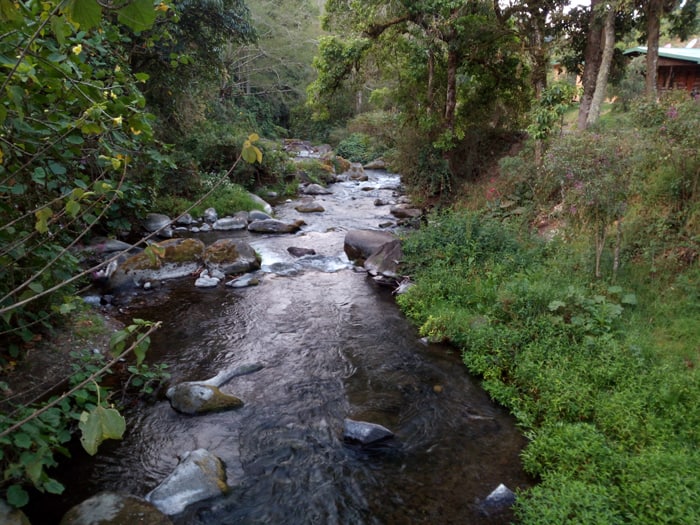Recently I was driving from Dominical to Quepos, on the Costenara highway. My first 20 years
in Costa Rica, this 40km stretch was unpaved, a bone-jarring 2+ hour travail.
I still remember how absolutely giddy I felt the first time I drove the new 40 km stretch, grinning nonstop now that the once torturous trek had been transformed into a 25-minute breeze.
As was my custom back when the road was bad, I stopped for a break at the Savegre River
bridge. There is a space with a ledge, a bit down the hill, right as you turn in toward the
mountains, and it is a good place to sit, relax, and watch the river.
At that spot, the Rio Savegre is bottoming out from its long savage run down the mountain.
In the late afternoon grayness that followed the day’s rains I saw that the river, even here, was swollen and rushing and mud brown, carrying branches and small pieces of zinc and wood. Something had been destroyed upriver, possibly somebody’s rancho, another lean-to built too close to the riverbank.
A convoy of tractor trailers roared over the bridge above. The rutted, broken excuse for a road
that had tormented drivers for years was now a part of the interamericana, the Pan-American
Highway.
That was civilization rumbling past me up there–and at that moment I saw a campesino hacking his way through the clump of jungled hillside that separated me from the highway.
Why he was patiently slicing a path with his machete at this spot was a mystery. I observed him in my side mirror, the churning river a blurred backdrop.
When he got within a few meters of my car he stopped and walked over. He stared out at the
river with me. We exchanged greetings. He had been up by the underside of the bridge,
scavenging.
He lived nearby, on the old unpaved road that had been left untouched when the new highway went in. It was raining regularly in the mountains and during the last rain he had salvaged 5000 colones worth of flotsam.
I commented that it was probably much nicer for him that the new road was in and he did not have to breathe dust in summer and slog through mud in the rainy season. He shrugged and began to talk. He had problems where he lived. Problems with the suegra—the mother-in-law. He was married to a 24 year old woman and lived with her and her mother and father.
Campesinos live hard, physical lives and it is often difficult to tell their age, but this guy’s gaunt body, lined face, and flickering eyes told of years of hard and poorly compensated labor. I guessed him to be between forty and fifty.
I smiled and congratulated him on having a much younger bride. He shook his head.. She’s epileptic, he said. She is very sick, always—siempre enferma. She has seizures.
He went through an entire reportoire of pantomimes– an open mouthed, twisted face, followed by a shaking upper body, followed by rolling his eyes up into his head– to illustrate what she looked like during a seizure. La pobrecita, he said. There had been numerous stays in the hospital, much suffering.
These tales of woe are not uncommon among the working rural poor here; it sometimes seems every other campesino family has a story to tell of a crazed homebound aunt or a crippled parent or some vago family member’s brood of underfed kids to care for.
He pulled a crumpled cigarette pack from his pocket, fished one out, and lit it up. He offered me
one as well, the last in the pack. “No gracias,” I said. “No fumo cigarros.”
He took a long drag and continued talking. He had come to this area ten years earlier to work on the palm plantations that line miles and miles of the central Pacific Costa Rican highway.
He moved into what he described as little more than a zinc shed on the property of his future wife’s family. She was 15 when he met her, and suffering from seizures even then. Her mother and father, he casually informed me, tied her to the kitchen table when they had to leave the house. I let this sink in. His tone was resigned, emotionless.
I repeated what he had said back to him in the form of a question. “Le amarró a la mesa de la cocina?” He nodded. His mother-in-law still wanted to tie her to the table when no one else was home and it was the source of much tension and disagreement.
I stared out at the muddy Rio Savegre, a river that in my 30 years here has carved new terrain and rerouted itself on more than one occasion: a wild, free-flowing river that dumps immeasurable volumes of water into the Pacific. He stared out as well, smoking, brooding. I started my car and said luego.
There was nothing else to talk about. He started back up the hill toward home, to the throwback life he shared with the in-laws and his poor tortured wife, La Pobrecita.
I turned onto the highway. Her face—or his imitation of her distorted face in the throes of a seizure– was in my head as I shifted gears and gunned the engine and headed north, toward Quepos.
Written by Matt Cassedy






